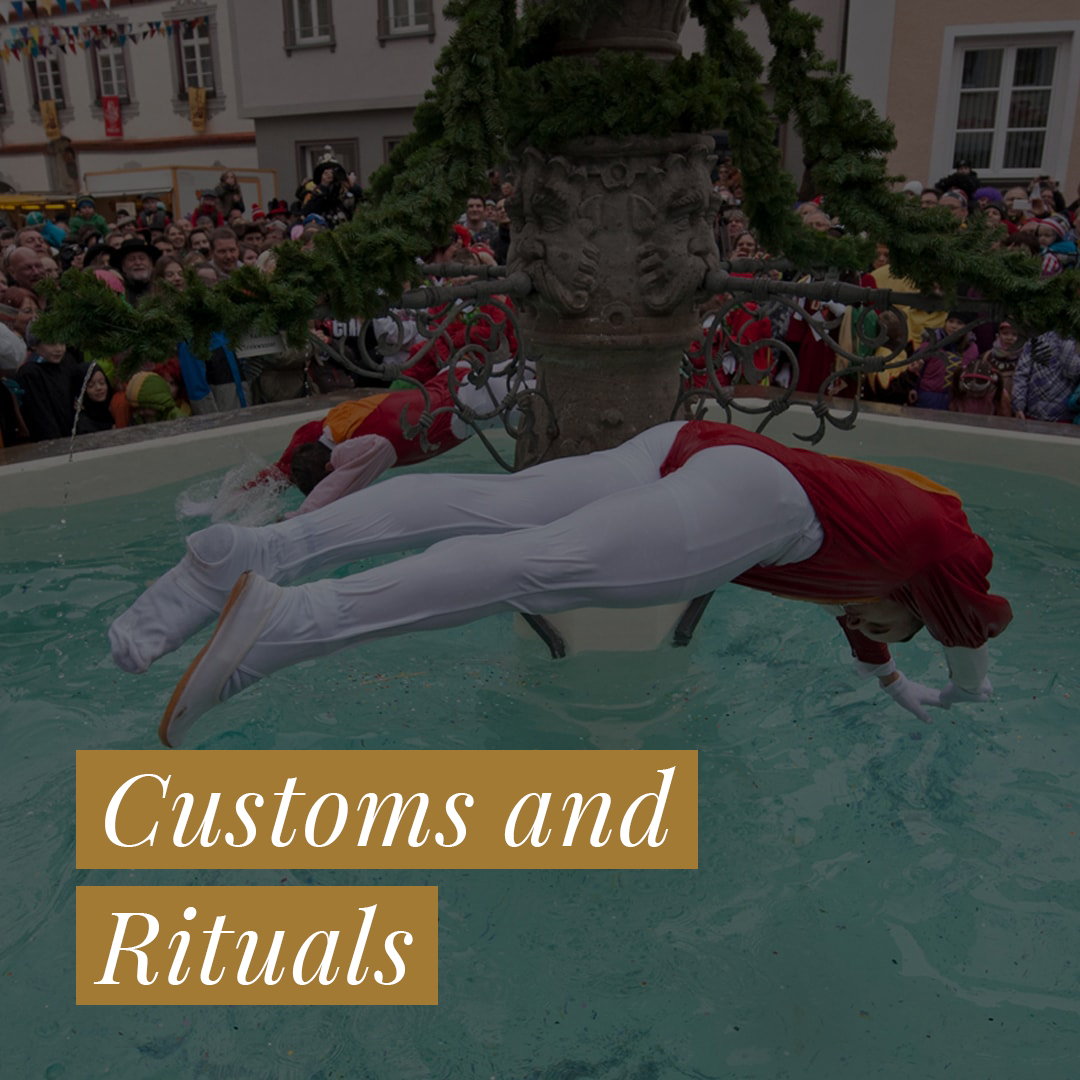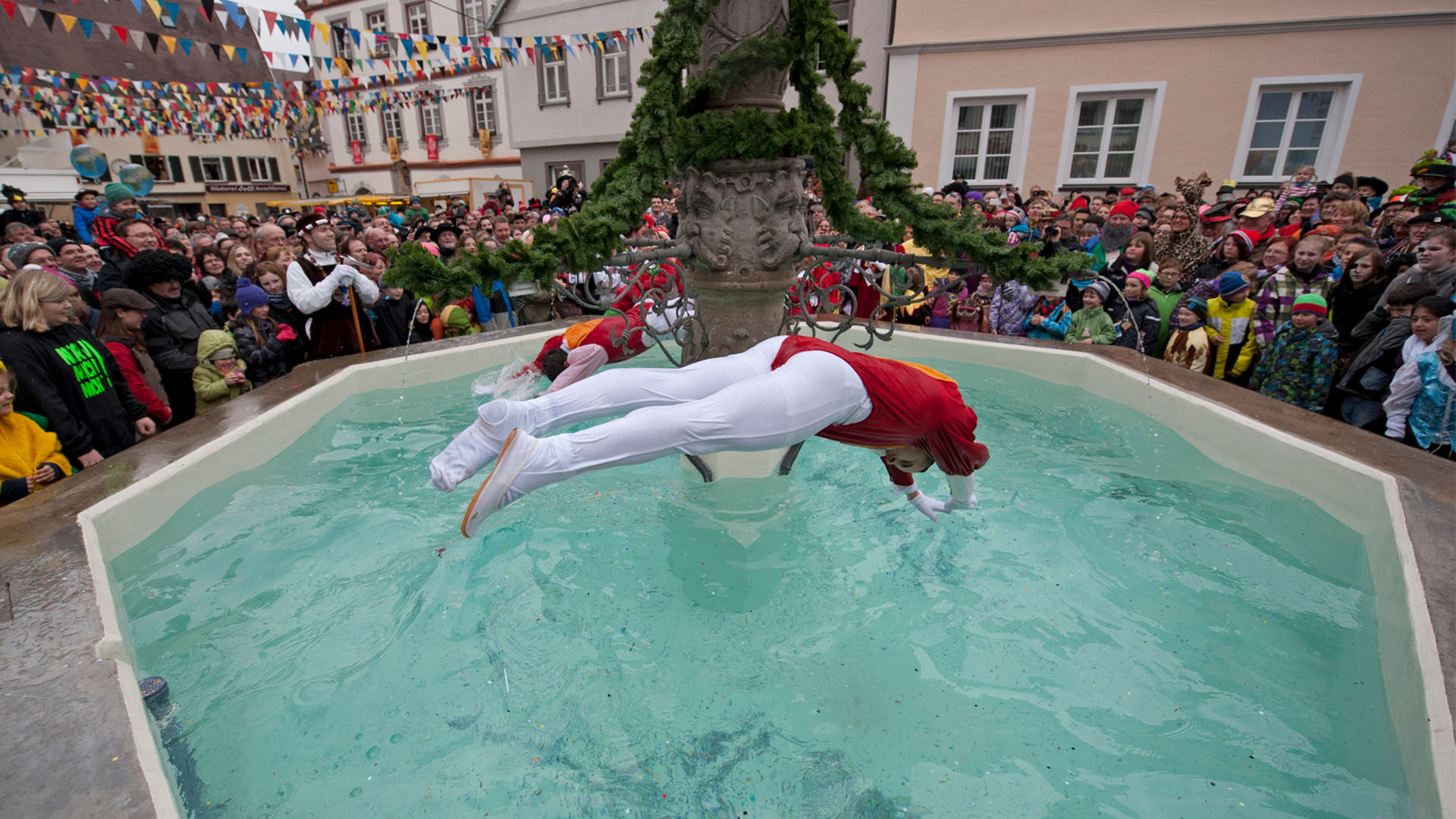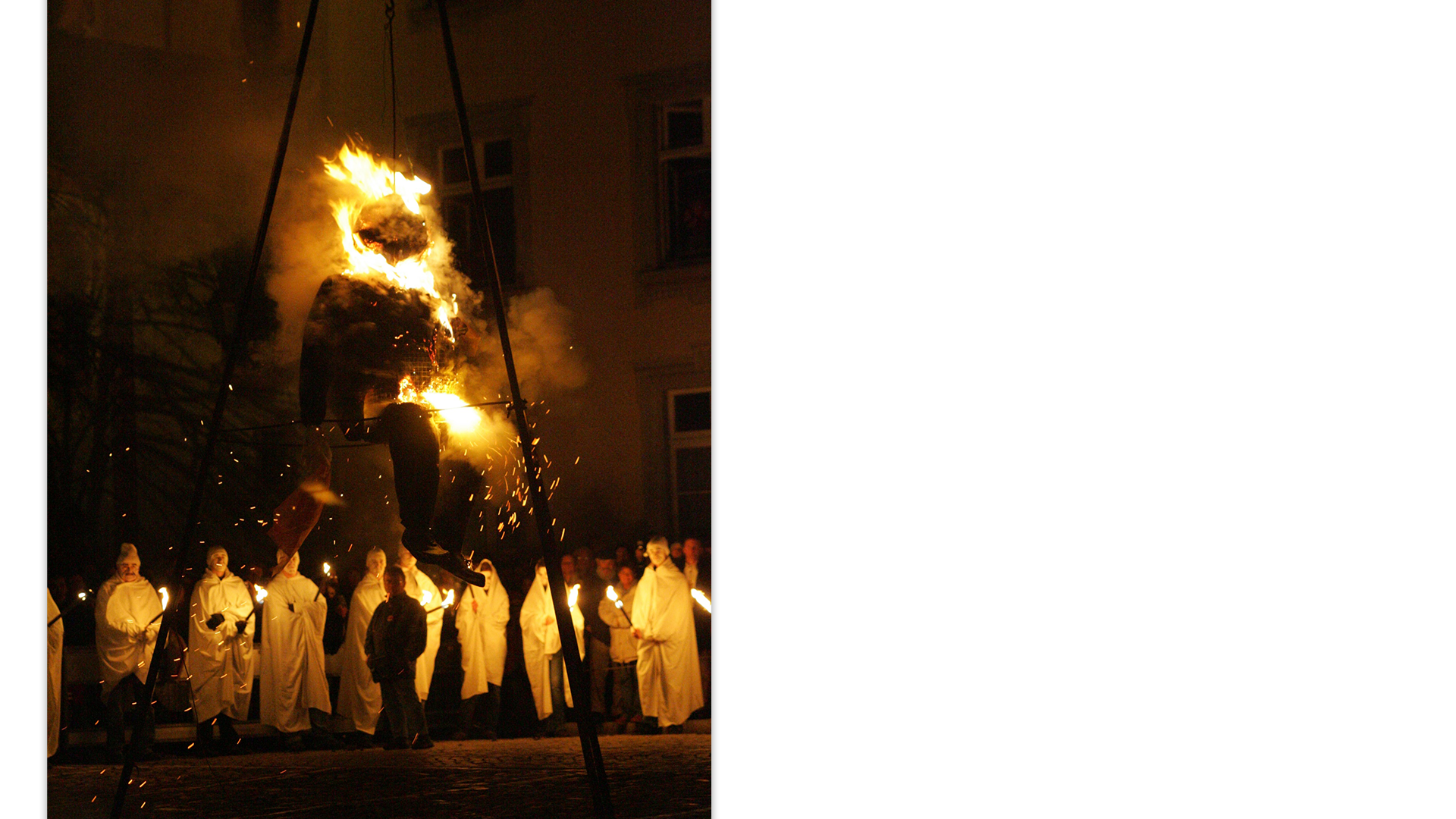Customs and Rituals

Dusting Off on Epiphany
Of the numerous customs and rituals seen throughout the Fastnacht festivities, only a few can be singled out here as examples. The Swabian-Alemannic Fastnacht kicks off on 6 January with Epiphany. This day – which marks the end of the Christmas season in the narrower sense – sees the “dusting off” in a number of Fastnacht locations. This is the case in Rottweil, for example, where black-clad men with top hats and a small brush or feather duster usually go around in groups of two, visiting the houses in which fool’s clothes and face masks are kept. These items, which have been locked away for the year, are then taken out of their boxes and chests. They are usually even placed next to the Christmas tree, and are then symbolically “freed” from the dust of the preceding months by the two visitors with all kinds of funny sayings. In this way, they are ready to be worn in the upcoming Fasnet.
“Dusters” on Epiphany in Rottweil, photo: Werner Mezger


Putting up the “fool’s tree” on “Dirty Thursday” in Stockach, photo: Ralf Siegele www.ralfsiegele.de
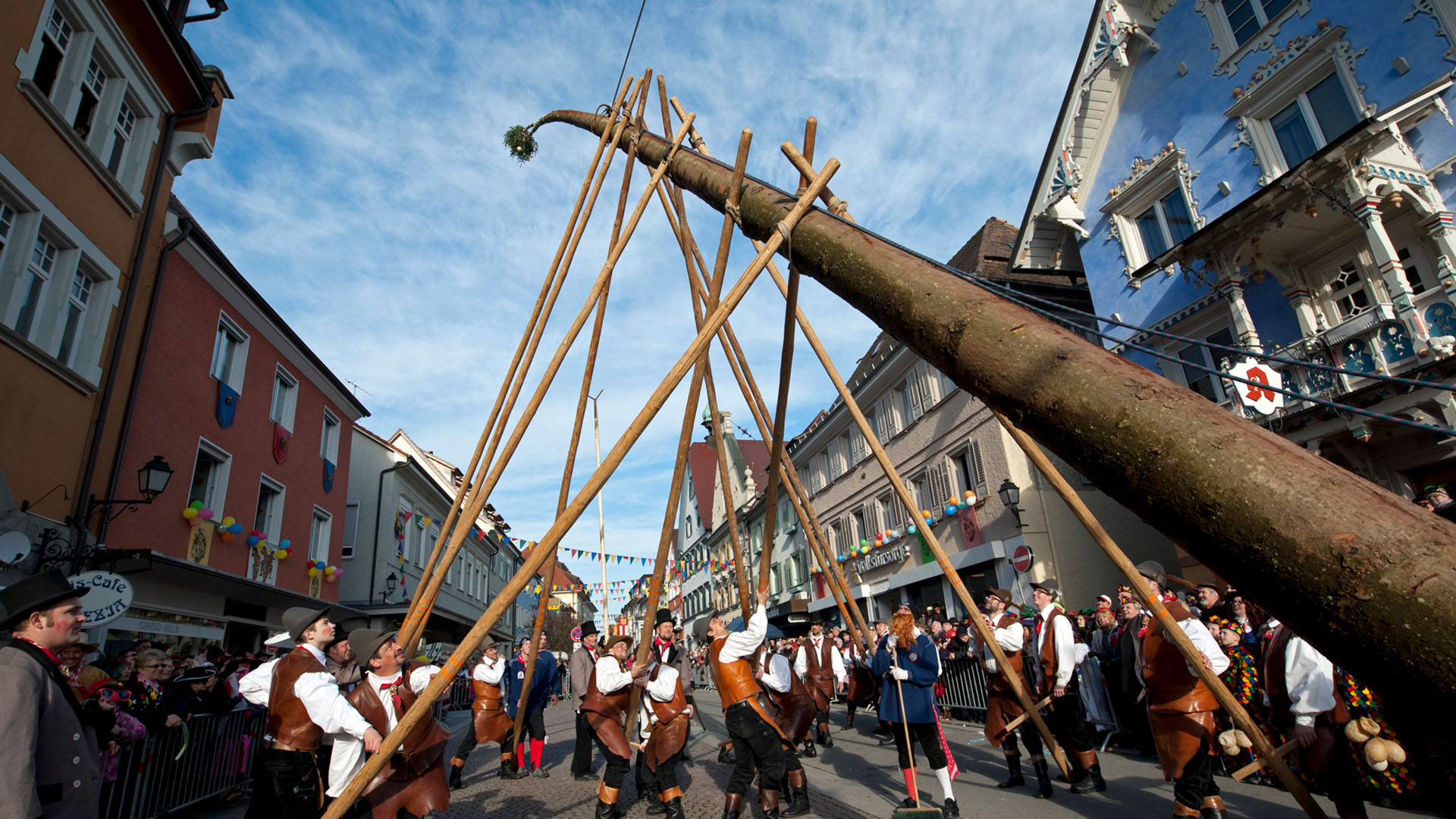
Putting Up the Fool’s Tree
In the Hegau-Bodensee area in particular, “Dirty Thursday”, which starts Fastnacht’s main six-day stretch, is the day on which the “fool’s trees” are put up. The trees serve as widely visible signs that the fools have taken over control. The Zimmerergilde (carpenter’s guild) in Stockach, near Konstanz, claims to have the largest tree. The locals confidently refer to it as the “family tree of all fools”. It owes its towering height to the fact that it is actually composed of two lopped tree trunks. Only at the very top do a few tree branches remain, which form the “umbels” hung with pig bladders. The fool’s tree in Stockach is not cut down at the end of Fastnacht like most others. It falls three weeks before Easter in the early hours of Laetare Sunday.

Putting up the “fool’s tree” on “Dirty Thursday” in Stockach, photo: Ralf Siegele www.ralfsiegele.de
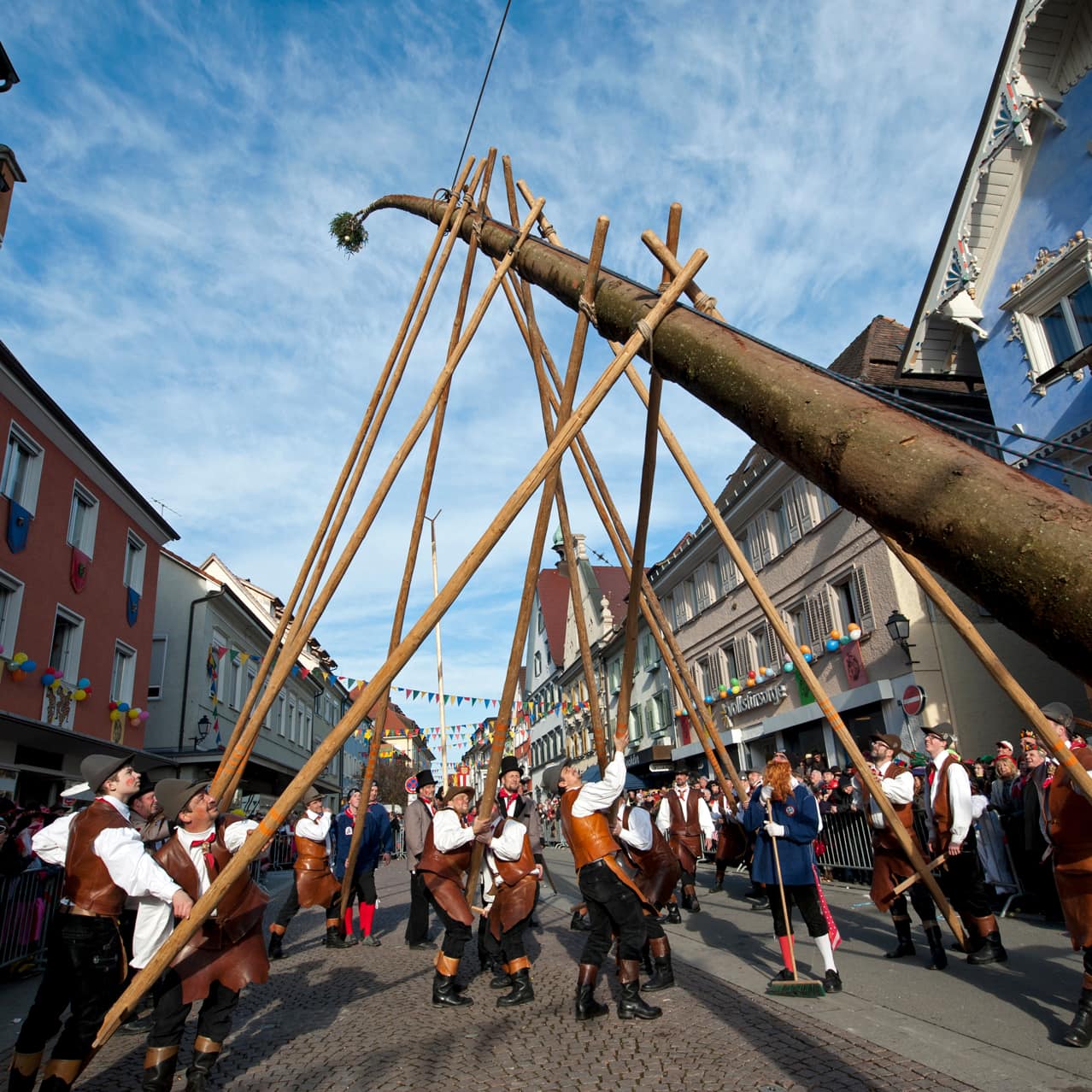
Putting Up the Fool’s Tree
In the Hegau-Bodensee area in particular, “Dirty Thursday”, which starts Fastnacht’s main six-day stretch, is the day on which the “fool’s trees” are put up. The trees serve as widely visible signs that the fools have taken over control. The Zimmerergilde (carpenter’s guild) in Stockach, near Konstanz, claims to have the largest tree. The locals confidently refer to it as the “family tree of all fools”. It owes its towering height to the fact that it is actually composed of two lopped tree trunks. Only at the very top do a few tree branches remain, which form the “umbels” hung with pig bladders. The fool’s tree in Stockach is not cut down at the end of Fastnacht like most others. It falls three weeks before Easter in the early hours of Laetare Sunday.

Putting up the “fool’s tree” on “Dirty Thursday” in Stockach, photo: Ralf Siegele www.ralfsiegele.de

Procession of the “Hemdglonker” on “Dirty Thursday” in Konstanz, photo: Ralf Siegele www.ralfsiegele.de

Procession of the ‘Hemdglonker’
In many Fastnacht strongholds, the “Hemdglonker” usually go around in the morning or in the evening of “Dirty Thursday”. Several hundred (and in some places even up to 2,000 to 3,000) participants parade through the dark streets in white nightgowns with sleeping caps on their heads, sometimes with flour-whitened faces. They make a deafening, generally rhythmic noise using a wide variety of items, which can range from grooved washboards to castanet-like “Kläpperle”. The nightwear-donning “Hemdglonker” are an expression of the inverted world, and predominantly have the task of “waking up” or welcoming Fasnet. Probably the biggest “Hemdglonker” procession in the Swabian-Alemannic region (where the classic image of the nightgown-wearing fools with sleeping caps has already been enhanced by all kinds of additions) takes place on the evening of Dirty Thursday in Konstanz.

Procession of the “Hemdglonker” on “Dirty Thursday” in Konstanz, photo: Ralf Siegele www.ralfsiegele.de
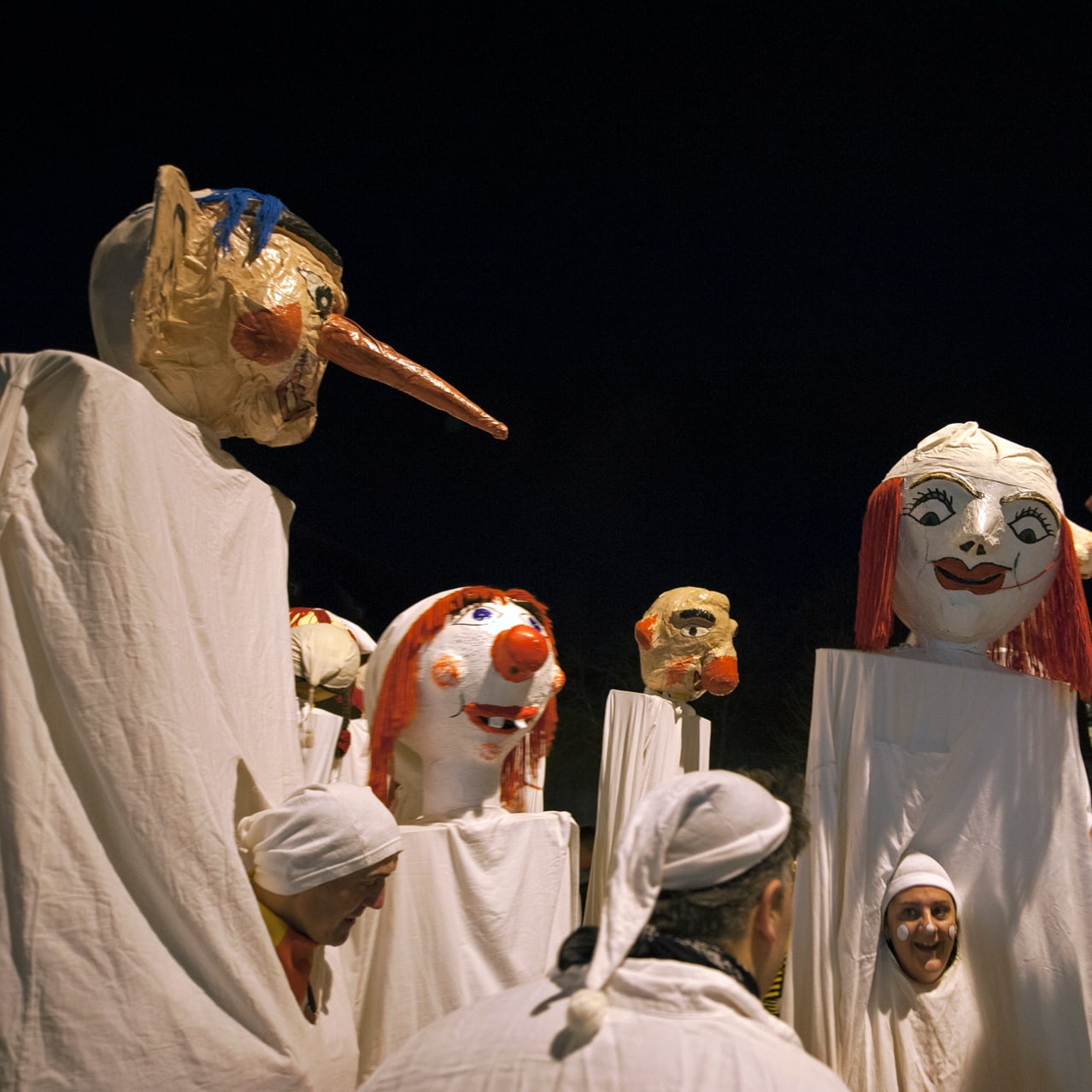
Procession of the ‘Hemdglonker’
In many Fastnacht strongholds, the “Hemdglonker” usually go around in the morning or in the evening of “Dirty Thursday”. Several hundred (and in some places even up to 2,000 to 3,000) participants parade through the dark streets in white nightgowns with sleeping caps on their heads, sometimes with flour-whitened faces. They make a deafening, generally rhythmic noise using a wide variety of items, which can range from grooved washboards to castanet-like “Kläpperle”. The nightwear-donning “Hemdglonker” are an expression of the inverted world, and predominantly have the task of “waking up” or welcoming Fasnet. Probably the biggest “Hemdglonker” procession in the Swabian-Alemannic region (where the classic image of the nightgown-wearing fools with sleeping caps has already been enhanced by all kinds of additions) takes place on the evening of Dirty Thursday in Konstanz.

Procession of the “Hemdglonker” on “Dirty Thursday” in Konstanz, photo: Ralf Siegele www.ralfsiegele.de

The Fools’ Jump
For centuries, the classic form of foolish self-representation has been the procession. Its origin ultimately lies in the Roman triumphal procession (from which, incidentally, the Christian processions also arose). In turn, the Fastnacht processions saw themselves as being the foolish counter-forms of precisely these historical acts. One of the most spectacular processions of the 15th century was the “Schembartlauf” in Nuremberg. As in the historical Roman and Christian processions, a strict order of appearance of the participants applied, and it was precisely specified who had to give way to whom. Today, there is hardly any Swabian-Alemannic Fastnacht without at least one (or usually several) processions. One of the most famous processions, which also impresses with its beautiful city backdrop, is the “Narrensprung” (“fools’ jump”) in Rottweil. Its start can be seen at the Schwarzes Tor here in a photo from the 1950s.

“Fool’s jump” in Rottweil at the end of the 1950s, photo: Stadtarchiv Rottweil

The Fools’ Jump
For centuries, the classic form of foolish self-representation has been the procession. Its origin ultimately lies in the Roman triumphal procession (from which, incidentally, the Christian processions also arose). In turn, the Fastnacht processions saw themselves as being the foolish counter-forms of precisely these historical acts. One of the most spectacular processions of the 15th century was the “Schembartlauf” in Nuremberg. As in the historical Roman and Christian processions, a strict order of appearance of the participants applied, and it was precisely specified who had to give way to whom. Today, there is hardly any Swabian-Alemannic Fastnacht without at least one (or usually several) processions. One of the most famous processions, which also impresses with its beautiful city backdrop, is the “Narrensprung” (“fools’ jump”) in Rottweil. Its start can be seen at the Schwarzes Tor here in a photo from the 1950s.

“Fool’s jump” in Rottweil at the end of the 1950s, photo: Stadtarchiv Rottweil
Foolish Generosity
The ritualised behaviour of many fools also includes handing out pastries, sausages or sweets to the spectators. The practice of gift-giving of the southwestern German “Hästräger” (costume wearers) cannot, of course, be compared with the overwhelming generosity of the “Jecken” (Karneval revellers) in the Rhineland, where tonnes of sweets (“Kamellen”) are thrown to the crowd during the Rose Monday procession. The fools from Oberndorf am Neckar, who have wooden poles stacked high with pretzels, are the most generous by Swabian standards. The fact that the pretzel was not originally a Fastnacht food (it was a devotional pastry that was eaten at the beginning of Lent or on important days in the calendar, such as New Year’s Day) has been forgotten today.
“Narro” from Oberndorf with a pretzel stick, photo: Ralf Siegele www.ralfsiegele.de

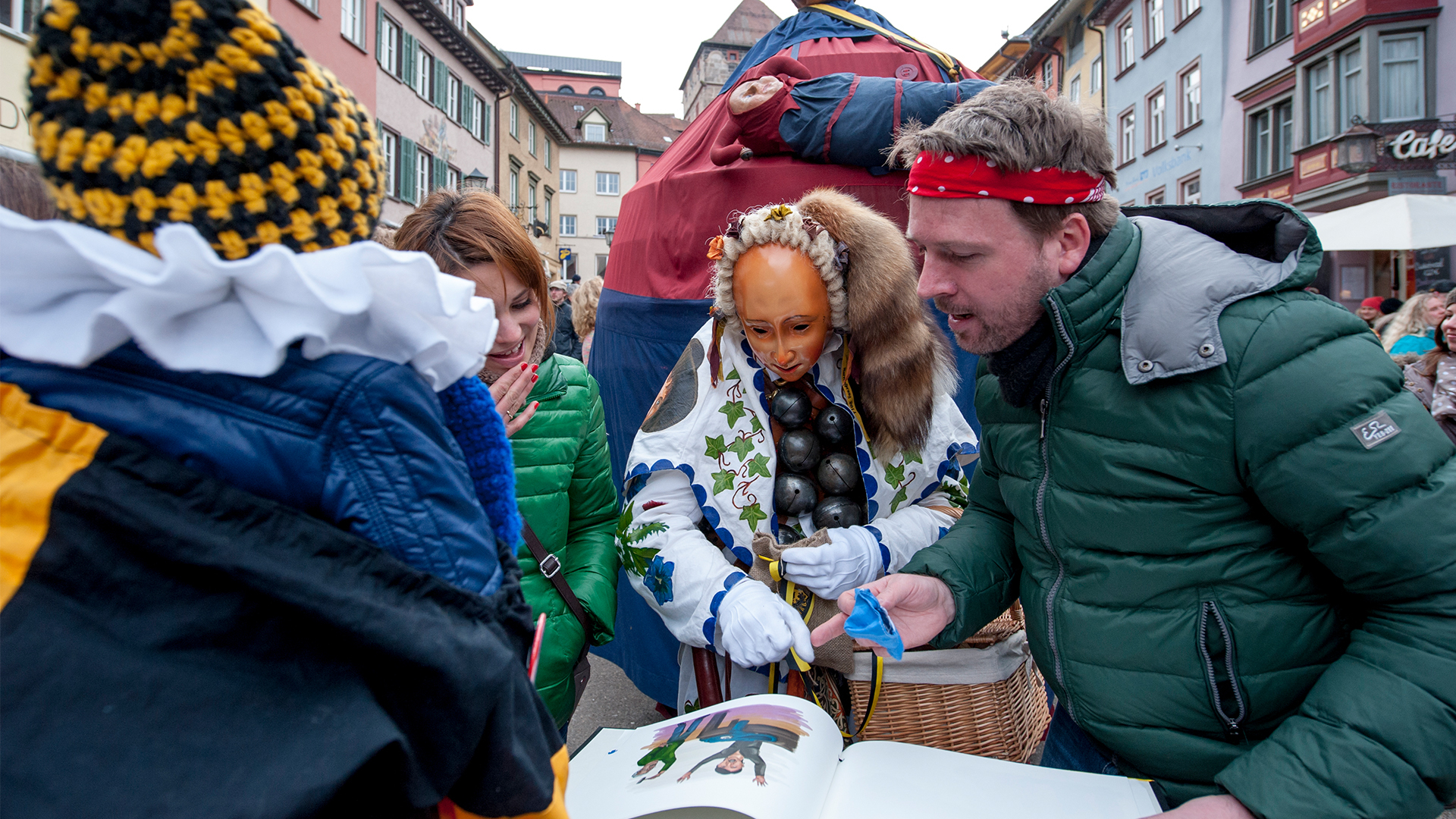
Truths from the Mouth of Fools
Being fully masked offers very special possibilities when it comes to exercising the fool’s right to complain and lament: Without revealing their own identity, the masked fools engage selected spectators in conversation, and discuss funny incidents or misadventures of the past year – preferably those in which they themselves were involved. In Rottweil, these “Narrenstückle” are even painted in books, and then annotated accordingly. Depending on the place or region, the dialogue between the disguised and the non-disguised has different names. On the upper Neckar it is called “Aufsagen” (“recital”), in Schömberg “Welschen”, in the Black Forest “Strählen” or “Schnurren”, and in Basel “Intrigieren”. The content of these very individual conversations is of course mostly about private matters, or at best about local issues. Major political issues, such as those taken up by the motif floats of the Rhineland, are not a feature of Swabian-Alemannic Fastnacht festivities. The range of foolish banter therefore depends largely on the respective communication situation.
“Aufsagen” in Rottweil, photo: Ralf Siegele


Truths from the Mouth of Fools
Being fully masked offers very special possibilities when it comes to exercising the fool’s right to complain and lament: Without revealing their own identity, the masked fools engage selected spectators in conversation, and discuss funny incidents or misadventures of the past year – preferably those in which they themselves were involved. In Rottweil, these “Narrenstückle” are even painted in books, and then annotated accordingly. Depending on the place or region, the dialogue between the disguised and the non-disguised has different names. On the upper Neckar it is called “Aufsagen” (“recital”), in Schömberg “Welschen”, in the Black Forest “Strählen” or “Schnurren”, and in Basel “Intrigieren”. The content of these very individual conversations is of course mostly about private matters, or at best about local issues. Major political issues, such as those taken up by the motif floats of the Rhineland, are not a feature of Swabian-Alemannic Fastnacht festivities. The range of foolish banter therefore depends largely on the respective communication situation.
“Aufsagen” in Rottweil, photo: Ralf Siegele

Social Criticism in Couplet Form
A custom of humorous review that is aimed at a significantly larger audience than the comparatively smaller “Strählen” or “Schnurren” is the “Sagt er” in Mühlheim an der Donau. On Shrove Monday morning, men in white miller’s shirts gather in a circle around a precentor and sing, in couplet form, about funny incidents from the town that have happened in the past twelve months. The performance style, based off of a style from Berlin, leads at the end of each verse to a standard formulation that puts the truth of what is being sung about into perspective again: “Sagt er” (“Says he”). This is ultimately from the Latin “Dicitur” (“So it is reported”). In other words: What you do and do not want to believe about the foolish chanting is for everyone to decide for themselves.
“Sagt er” in Mühlheim an der Donau, photo: Ralf Siegele, www.ralfsiegele.de


The Stockach Fool’s Court
Spectacular comical lawsuit customs where the public forum is part of the institution itself form part of the historical fool’s courts. The most famous one at present is undoubtedly found in Stockach, whose bearers can be traced back to the court jester Hans Kuony von Stocken from the 14th century. After an eventful history, the “fool’s court” today prefers to summon before its bars prominent political figures who have done something foolish during the year. The “trial” process has a fixed allocation of roles. First, the defendant is accused by a plaintiff and then defended by an advocate. Only then does the defendant’s own defence – eagerly awaited by all – follow. No matter how unsubstantial or convincing the latter is, no one escapes punishment in Stockach: The penalty is to be paid in considerable quantities of wine, which must be delivered to the fool’s court.

“Fool’s court” in Stockach, photo: Narrengericht Stockach Foto: Wikipedia (CC)
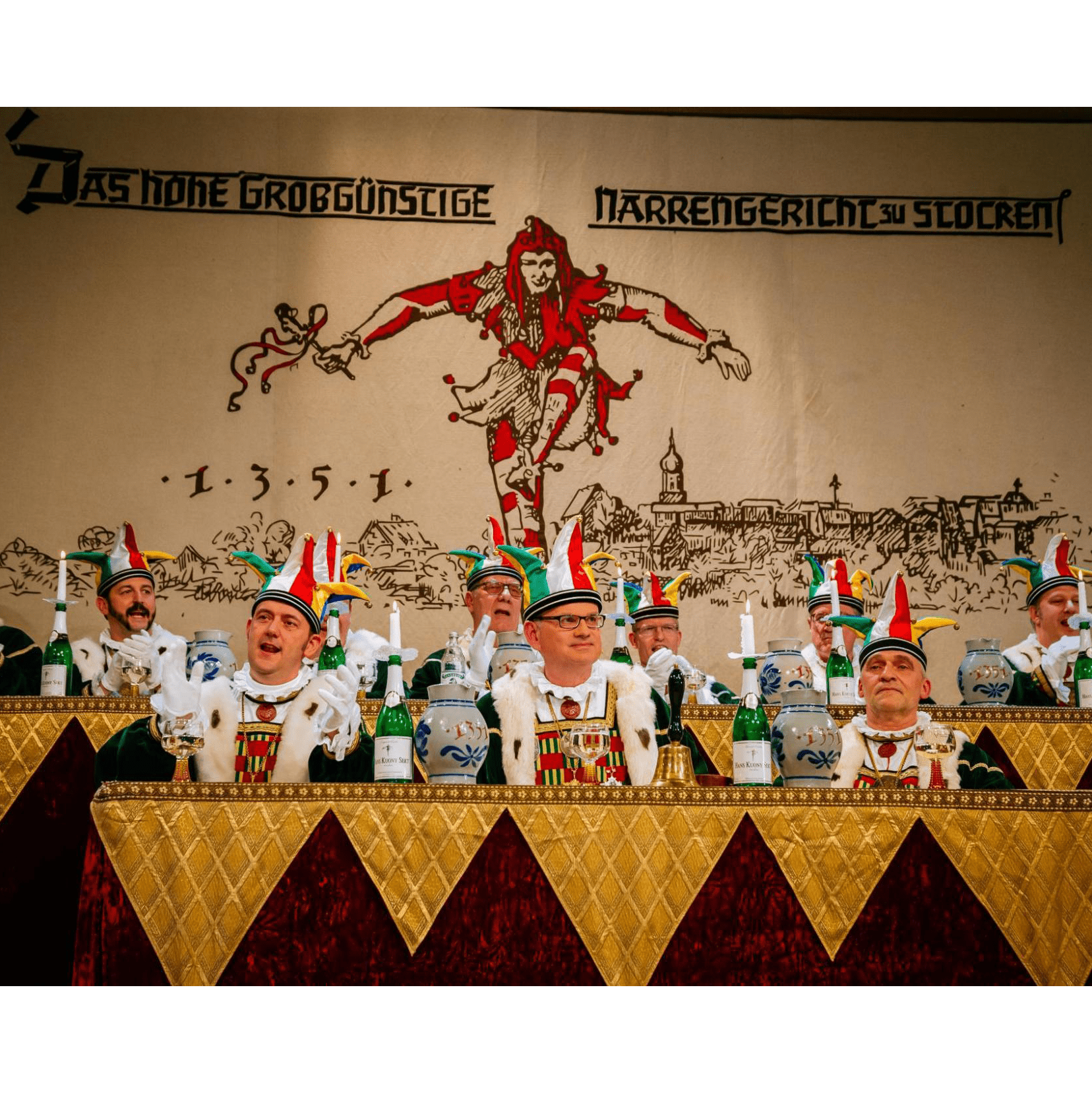
The Stockach Fool’s Court
Spectacular comical lawsuit customs where the public forum is part of the institution itself form part of the historical fool’s courts. The most famous one at present is undoubtedly found in Stockach, whose bearers can be traced back to the court jester Hans Kuony von Stocken from the 14th century. After an eventful history, the “fool’s court” today prefers to summon before its bars prominent political figures who have done something foolish during the year. The “trial” process has a fixed allocation of roles. First, the defendant is accused by a plaintiff and then defended by an advocate. Only then does the defendant’s own defence – eagerly awaited by all – follow. No matter how unsubstantial or convincing the latter is, no one escapes punishment in Stockach: The penalty is to be paid in considerable quantities of wine, which must be delivered to the fool’s court.

“Fool’s court” in Stockach, photo: Narrengericht Stockach Foto: Wikipedia (CC)

The Grosselfingen Fool’s Court
Not quite as well known in the media as the Stockach fool’s court – but the best documented Fastnacht custom in the entire German-speaking area – is the “Honourable Fool’s Court of Grosselfingen”, which can be traced back to the 16th century. When the court sits – which only happens every few years – the village at the foot of Hohenzollern Castle is transformed into the “Venetian Empire” for the duration of the play. Parallel to the court hearings, a complex play takes place with the participation of around 300 male residents with precisely defined roles, whose plot elements sometimes even run simultaneously. Those of the “higher ranks” – that is, the holders of distinguished roles – wear the letters “H.v.V.” (standing for “Gentlemen of Venice”, in German “Herren von Venedig”) on their caps. The “Honourable Fool’s Court of Grosselfingen” is the last surviving remnant of the “kingdoms of fools” that were set up in many places in the early modern era during Fastnacht as utopian structures of rule.

“Honourable Fool’s Court” in Grosselfingen, photo: Ralf Siegele, www.ralfsiegele.de
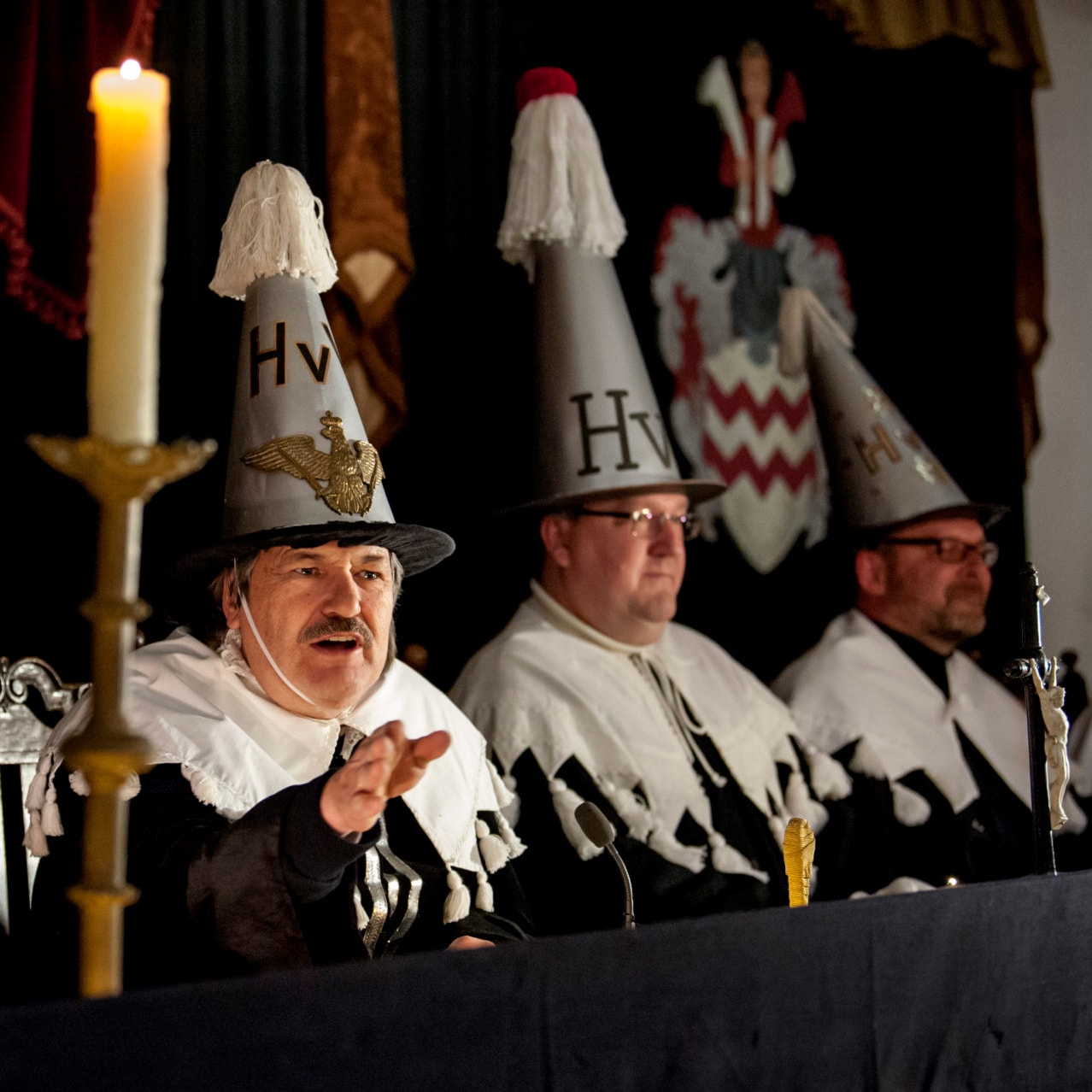
The Grosselfingen Fool’s Court
Not quite as well known in the media as the Stockach fool’s court – but the best documented Fastnacht custom in the entire German-speaking area – is the “Honourable Fool’s Court of Grosselfingen”, which can be traced back to the 16th century. When the court sits – which only happens every few years – the village at the foot of Hohenzollern Castle is transformed into the “Venetian Empire” for the duration of the play. Parallel to the court hearings, a complex play takes place with the participation of around 300 male residents with precisely defined roles, whose plot elements sometimes even run simultaneously. Those of the “higher ranks” – that is, the holders of distinguished roles – wear the letters “H.v.V.” (standing for “Gentlemen of Venice”, in German “Herren von Venedig”) on their caps. The “Honourable Fool’s Court of Grosselfingen” is the last surviving remnant of the “kingdoms of fools” that were set up in many places in the early modern era during Fastnacht as utopian structures of rule.

“Honourable Fool’s Court” in Grosselfingen, photo: Ralf Siegele, www.ralfsiegele.de

Dragging the Plough
In Fridingen, dragging the plough also originated from a custom surround lament and mockery. In the small town on the Danube, all the fools walk on a long rope with a plough hanging from the end of it, led by a farmer dressed as a ploughman (the “plough leader”, in the local dialect “Pflugheber”). Immediately in front of and next to him, sowers scatter chaff on the road instead of grains – a seed that will never sprout. The plough is followed by a harrow, and the end of the procession is formed by the “old women” with their “Hacken” (Swabian for “hoes”), who effectively finish off the outlandish task. In earlier centuries, dragging the plough and sowing chaff were used to ridicule single women. It was said that, since they had not found partners, men had to be sown for them first. Today, this disparaging meaning of what used to be a widespread ritual has fortunately been forgotten.
Dragging the plough in Fridingen an der Donau, photo: Ralf Siegele www.ralfsiegele.de


Dragging the Plough
In Fridingen, dragging the plough also originated from a custom surround lament and mockery. In the small town on the Danube, all the fools walk on a long rope with a plough hanging from the end of it, led by a farmer dressed as a ploughman (the “plough leader”, in the local dialect “Pflugheber”). Immediately in front of and next to him, sowers scatter chaff on the road instead of grains – a seed that will never sprout. The plough is followed by a harrow, and the end of the procession is formed by the “old women” with their “Hacken” (Swabian for “hoes”), who effectively finish off the outlandish task. In earlier centuries, dragging the plough and sowing chaff were used to ridicule single women. It was said that, since they had not found partners, men had to be sown for them first. Today, this disparaging meaning of what used to be a widespread ritual has fortunately been forgotten.
Dragging the plough in Fridingen an der Donau, photo: Ralf Siegele www.ralfsiegele.de


‘Altweibermühle’
Another custom that is not unproblematic from a gender perspective is the “Altweibermühle” (“old wives’ mill”). Analogous to the grain mill, which makes flour out of grain, the fictional image of the “young mill” developed, in which old people become youthful again during the grinding process. In addition to the “old wives’ mill”, there was also its counterpart from an early stage: the “old mens’ mill” (“Altmännermühle”). As a visual representation, however, only the rejuvenation spectacle related to women has prevailed. The Wolfach Old Wives’ Mill, which is performed every five years on “Schellenmentig” (Shrove Monday), goes back to a Fastnacht play by the royal Fürstenberg school inspector Georg Anton Bredelin from 1787. The victims who are put into the grinding funnel today are the Wolfach “Rungunkeln” (Fastnacht witches). This custom of slapstick alienation is also no longer seen as misogynistic.
“Old wive’s mill” in Wolfach, photo: Ralf Siegele www.ralfsiegele.de


‘Altweibermühle’
Another custom that is not unproblematic from a gender perspective is the “Altweibermühle” (“old wives’ mill”). Analogous to the grain mill, which makes flour out of grain, the fictional image of the “young mill” developed, in which old people become youthful again during the grinding process. In addition to the “old wives’ mill”, there was also its counterpart from an early stage: the “old mens’ mill” (“Altmännermühle”). As a visual representation, however, only the rejuvenation spectacle related to women has prevailed. The Wolfach Old Wives’ Mill, which is performed every five years on “Schellenmentig” (Shrove Monday), goes back to a Fastnacht play by the royal Fürstenberg school inspector Georg Anton Bredelin from 1787. The victims who are put into the grinding funnel today are the Wolfach “Rungunkeln” (Fastnacht witches). This custom of slapstick alienation is also no longer seen as misogynistic.
“Old wive’s mill” in Wolfach, photo: Ralf Siegele www.ralfsiegele.de

Well Jump
One of the classic end-of-Fastnacht customs used to see one or more young men jumping into the cold water of a well, symbolising the drowning or downfall of foolishness. This probably also acted as a kind of “purification” ritual. Because of the danger of performing this custom – there were cardiac arrests and deaths – the well jumps were gradually banned. Only in Munderkingen, near Ulm, has the wet and cold spectacle survived to this day – albeit as the core part of Fastnacht festivities, not the finale. Year after year, two young men jump headfirst into the well after elaborate preparation rituals – from drawing lots for the main participants, to stirring the water by the “Maischer”. As soon as they re-emerge they climb onto the edge of the well again and repeat the daring action two more times. When they finally emerge from the cool water after the third jump, they are allowed to kiss all the girls who have gathered around the fountain.
“Well jump” in Munderkingen, photo: Ralf Siegele www.ralfsiegele.de

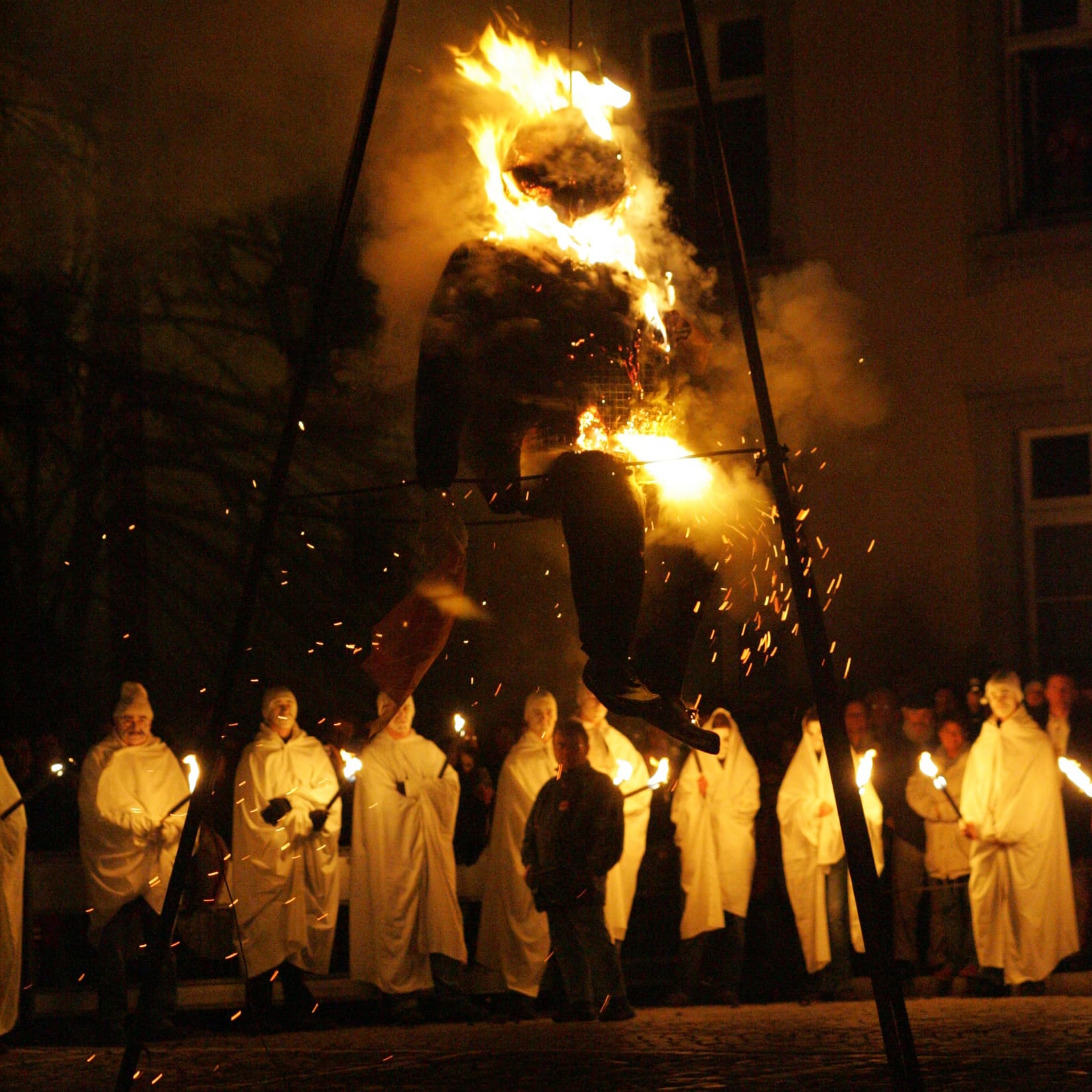
Burning Fastnacht
A still widely practised farewell ritual to the festivities is the night time burning of Fastnacht immediately before the dawn of Ash Wednesday. This can take place in different ways. Usually, a straw doll that serves to symbolise the foolishness of the festivities goes up in flames. In Bad Säckingen, the straw figure that gets burnt is called “Böög” in Alemannic. When the figure is burnt to ashes, the “Hüüler” (“howlers”) dressed in white nightgowns wail loudly through all the streets and corners, mourning the loss of Fastnacht. An example of catechesis is the custom in many places in Italy of laying the ash cross on the faithful on Ash Wednesday in church with the ashes of Don Carnevale, who was burnt the evening before.
Burning “Böögg” in Bad Säckingen, photo: Ralf Siegele, www.ralfsiegele.de



